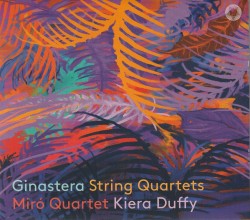 Ginastera – String Quartets
Ginastera – String Quartets
Miró Quartet; Kira Duffy
Pentatone PTC5187412 (pentatonemusic.com/product/ginastera-string-quartets)
Argentina’s greatest composer, Alberto Ginastera (1916-1985), divided his career into three stylistic phases, composing one string quartet in each of them. No.1, Op.20 (1948) typifies what Ginastera named “Objective Nationalism,” evoking the vibrant melodies and rhythms of Argentine folk music. The 6/8 syncopations of the melambo, a traditional gaucho dance, dominate the first and fourth movements. The second movement, Vivacissimo, is a gossamer, quicksilver scherzo, while the third, Calmo e poetica, is a melancholy meditation.
In No.2, Op.26 (1958, rev.1968), reflecting Ginastera’s “Subjective Nationalism” period, he superimposed Schoenbergian dodecaphony upon what he called “constant Argentine elements such as strong, obsessive rhythms… the quietness of the pampas, magic, mysterious sounds reminding one of the cryptic nature of the country.” The opening Allegro rustico alternates aggression with uncertainty; Adagio angoscioso wanders through dark labyrinths; Presto magico is another diaphanous scherzo; Libero e rapsodico is an intense set of variations on Ginastera’s song Triste el dio sin sol; the finale, a perpetuum mobile, is appropriately titled Furioso.
Ginastera added the human voice to the extravagantly emotional No.3, Op.40 (1973, rev.1978), a product of his “Neo-Expressionism” period. American Kiera Duffy’s shining soprano illuminates verses by 20th-century Spanish poets Juan Ramón Jiménez, Federico García Lorca and Rafael Alberti that embrace musical and sexual ecstasy, violent death and the silence of eternity.
The Texas-based Miró Quartet effectively produces textures from ethereal to caustic in these powerfully expressive quartets, each very different, each very rewarding to hear.



